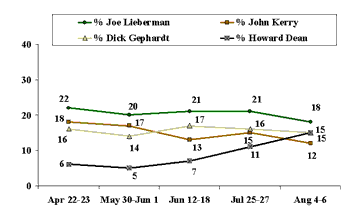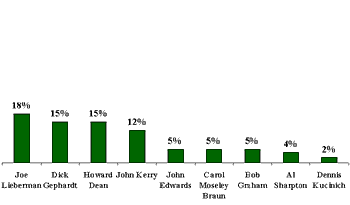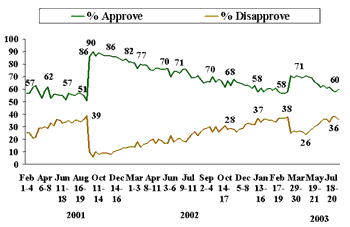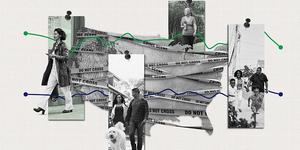GALLUP NEWS SERVICE
PRINCETON, NJ -- Former Vermont Gov. Howard Dean has gained 10 points in the Democratic horse race over the last two months, and is now tied for second among the list of nine Democratic contenders for their party's presidential nomination. Connecticut Sen. Joe Lieberman -- well-known from his position as Al Gore's vice-presidential running mate in the 2000 election -- maintains a slight lead over Dean and Missouri Congressman Dick Gephardt. At the same time, the new Gallup Poll shows no sign of further deterioration in President George Bush's position in the eyes of the public; his job approval rating is steady at 60%.
Dean Has the Momentum
There's little question in the minds of most observers that Dean currently has the buzz and momentum in the race for the Democratic nomination. Dean has been widely profiled in many of the nation's newspapers and television broadcasts, he has established a remarkable ability to raise money using the Internet, and this week he pulled off the relatively rare feat of being featured on the covers of both TIME and Newsweek magazines.
As recently as early June 2003, Dean was getting only 5% of the projected vote of registered Democrats when they were asked whom they would be most likely to support as the Democratic presidential nominee. Then, by mid-June, Dean's percentage of the vote was up to 7%, then to 11% in July, and now is at 15% in our most recent CNN/USA Today/Gallup poll completed Aug. 6.
| Democratic Nomination Leaders 2003 Trend in Support Among Registered Democrats and Democratic Leaners |
 |
Support for other leading candidates has moved in the opposite direction. Lieberman's percentage of the vote has dropped from 22% in April to his current 18%, and Kerry has gone from a high point of 18% in April to 12% now. Gephardt's support levels have held, and his current 15% is just one point different from the 16% he obtained in April.
The current projected vote for all nine major Democratic candidates looks like this:
| Democratic Presidential Trial Heat Based on Democrats and Democratic Leaners Who Are Registered Voters |
 |
| August 4-6, 2003 |
There are four candidates who are fairly closely bunched as front-runners: Lieberman, Gephardt, Dean, and Kerry. All other candidates are mired at the 5% level or lower, including North Carolina Sen. John Edwards and Florida Sen. Bob Graham.
History shows that a great deal can change between now and next year. Candidates such as Bill Clinton and Jimmy Carter were near the bottom in these types of horse-race lists at this point a year before the election, yet they went on to win their party's nomination.
Still, Dean's upward momentum -- coupled with the fact that polling shows him doing well in the key early primary and caucus states of New Hampshire and Iowa -- makes him the candidate to watch at the moment.
Bush Job Approval
President George W. Bush's job approval rating is at 60% in the latest Aug. 4-6 Gallup Poll -- essentially unchanged since late June and very similar to the ratings he was receiving in the first months of this year before the Iraq war.
| George W. Bush's Job Approval Rating |
 |
This period of leveling off for a president's job approval rating is not uncommon. One important comparison point for Bush's job approval is the trend line of George H.W. Bush's job approval ratings in 1991. The elder Bush's rating dropped rapidly from a high point of 89%, measured just as the Persian Gulf War was ending, to 72% in June 1991. At that point, however, Bush's ratings stabilized, and stayed at about that level through the next three months, even rising slightly to 74% by late August. As the fall began, however, his ratings resumed their downward trajectory, ending up at 50% by the end of 1991.
Survey Methods
The most recent results are based on telephone interviews with 1,003 national adults, aged 18 and older, conducted Aug. 4-6, 2003. For results based on the total sample of national adults, one can say with 95% confidence that the margin of sampling error is ±3 percentage points.
For results based on the sample of 391 Democrats and Democratic leaners who are registered to vote, the maximum margin of sampling error is ±6 percentage points.
In addition to sampling error, question wording and practical difficulties in conducting surveys can introduce error or bias into the findings of public opinion polls.
